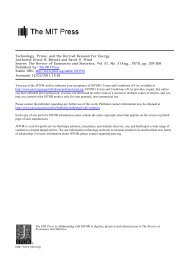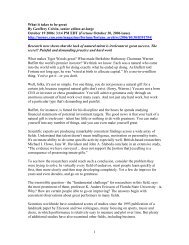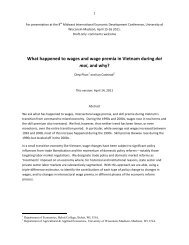Capital-Labor Substitution and Economic Efficiency Author(s): K. J. ...
Capital-Labor Substitution and Economic Efficiency Author(s): K. J. ...
Capital-Labor Substitution and Economic Efficiency Author(s): K. J. ...
Create successful ePaper yourself
Turn your PDF publications into a flip-book with our unique Google optimized e-Paper software.
CAPITAL-LABOR SUBSTITUTION AND ECONOMIC EFFICIENCY 237<br />
Substituting from (29) for the efficiency ratio<br />
<strong>and</strong> taking logs we get a formula comparable<br />
to equation (8) from which our elasticity esti-<br />
mates were derived:<br />
log Y = (a + e - ea) log (W(3A<br />
Y'B WB<br />
Comparing (8) <strong>and</strong> (3I), we see that the re-<br />
gression coefficient b is equal to (o-+e-eo-), or<br />
b-e (32)<br />
b-e<br />
i - e<br />
Therefore it is only when efficiency does not<br />
vary with w - i.e. when e = o - that b is<br />
equal to o-. For e > o, o- must be still smaller<br />
than b, <strong>and</strong> therefore, a fortiori, less than i<br />
when b < i.<br />
To get a rough idea of the magnitude of the<br />
correction, we normalized the y's in Table 3 sO<br />
that the United States value equals one in each<br />
case <strong>and</strong> then fitted log y to log w by least<br />
squares.14 We obtain the following result from<br />
the combined sample of I4 observations:<br />
logy .323 log w -.039 R2 = .82.<br />
(.043)<br />
The separate industries vary somewhat, but the<br />
number of observations in each is too small for<br />
reliable estimates. Another source of informa-<br />
tion on e is provided by the comparisons of<br />
Japan with the United States in section IV,<br />
which cover io manufacturing industries. Here<br />
the median value of (yJ/yu) is about .35, cor-<br />
responding to a value of e of about .5.<br />
For values of b less than i, equation (32)<br />
shows that variation of efficiency with the wage<br />
rate will reduce the estimate of a-. Taking e= .3,<br />
values of b of .9, .8, <strong>and</strong> .7 yield values of .86,<br />
.7i, <strong>and</strong> .57. At the median value of b =.87<br />
observed in Table 2, the corresponding C- is .8i.<br />
2. Residual variation by country. The ex-<br />
tent of the deviation of observed values of value<br />
added per unit of labor in each country from the<br />
values predicted by the regression equations is<br />
shown in Table 4. Apart from errors of ob-<br />
servation, there are three main causes of these<br />
differences between the predicted value (9 = a<br />
+ b log p ) <strong>and</strong> the observed value (y = V/L):<br />
"This procedure is not strictly correct, since y is com-<br />
puted from an assumed value of a which is subsequently to<br />
be corrected, but it is roughly valid since y is insensitive to<br />
variations in a.<br />
(a) Variations in efficiency, which affect L<br />
only.<br />
(b) Variations in commodity prices, which<br />
affect both V <strong>and</strong> W/P. The net effect<br />
depends on the magnitude of the differ-<br />
ence (i - b).<br />
(c) Variations in the exchange rate, which<br />
affect V but not W/P.<br />
The following deviations in each factor are<br />
associated with positive <strong>and</strong> negative values of<br />
(y - ):<br />
Positive Residuals Negative Residuals<br />
<strong>Efficiency</strong> Relatively efficient Relatively inefficient<br />
Commodity price High Low<br />
Exchange rate Overvalued Undervalued<br />
TABLE 4.- RESIDUAL VARIATION IN (V/L)<br />
BY COUNTRY a<br />
Number of Industries<br />
Between<br />
Average Averageb Above +5% <strong>and</strong> Below<br />
V (%) +5% -5% - 5s%io<br />
() (2) (3) (4) (5)<br />
United States 384I +5 I0 II 3<br />
Canada 3226 +5 9 II 3<br />
New Zeal<strong>and</strong> i980 +4 7 7 8<br />
Australia I926 -I2 I 3 20<br />
Denmark I455 -8 2 6 i6<br />
Norway I393 -9 2 6 I5<br />
Puerto Rico II82 +22 9 I 8<br />
United Kingdom I059 -II I 4 I9<br />
Colombia 924 +I4 i6 2 6<br />
Irel<strong>and</strong> 900 -i8 0 2 I2<br />
Mexico 524 +3 2 I9 3 X<br />
Argentina 5I9 +I0 I2 5 7<br />
Japan 476 +7 9 5 9<br />
Salvador 445 + I2 Io I 5<br />
Brazil 436 +33 9 0 1<br />
Southern Rhodesia 384 -i8 0 2 4<br />
Ceylon 26I +7 5 a 6<br />
India 24I -23 0 2 i6<br />
Iraq 2I3 +I I 0 I<br />
a Residual Ay = y derived from Table 2.<br />
b Arithmetic mean of (Ay/y).<br />
Although we cannot separate these causes in<br />
countries for which we do not have observations<br />
of relative prices, the observed residuals help in<br />
the interpretation of our previous results. Of<br />
the five countries analyzed in Table 3, the<br />
United States, Canada, <strong>and</strong> Japan have small<br />
average deviations, <strong>and</strong> hence little country bias<br />
is introduced into any conclusions based on<br />
them. The United Kingdom <strong>and</strong> India have<br />
predominantly negative residuals in V/L, prob-<br />
ably due to undervalued exchange rates. Cor-<br />
rection of Table 3-B to allow for these possible







